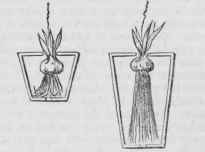Hyacinthus. Part 2
Description
This section is from the book "A Dictionary Of Modern Gardening", by George William Johnson, David Landreth. Also available from Amazon: The Winter Harvest Handbook: Year Round Vegetable Production Using Deep Organic Techniques and Unheated Greenhouses.
Hyacinthus. Part 2
Taking Up And Storing
"In July, the bulbs are taken up, and the leaves being pulled off, they are laid down regularly, each bulb on the side, so as to prevent the roots growing again; after this they are covered over with dry soil, one inch above the bulbs, and remain in this state for about a fortnight, to separate the roots and loose skins easily from the bulbs. Great care must be taken during this time that no injury be done to the bulbs by the sun; attention should therefore be paid to keep them well covered over. When taken from this situation, the bulbs are exposed for a few hours to the sun, and kept continually moving with a large brush, to prevent their being scorched; by which means they get that glossy appearance always observed in imported bulbs." - Card. Chron.
"After this management the bulbs require a few weeks' drying in the warehouse; for which purpose they are laid out on platforms, raised a foot and a half above each other, which enables us to look them over occasionally, though this is done principally that they may have a good circulation of air between them. The windows are opened every day on both sides of the warehouse - for the more air and wind we are able to give, the better - that they may be dried and be ready to be packed." - Gard. Chron.
Frost
"Frost," says Mr. Horne, "is detrimental only when it comes in contact with the bulbs; therefore they should be protected in proportion to its intensity. Those who have bulbs of great value may lay thin planks of wood over the surface when the frost is very intense; but care must be taken not to cover them too deep, especially with the leaves of trees, because these coverings retain the vapour which arises from the soil, and hinder the air from entering and purifying it." - Gard. Chron.
Growing In Pots
The latest and best directions we have on this point are the following: - "Give them enough space to grow in, without starving their roots. The easiest way to do this is to have pots made of a deeper shape than those in common use.
"By this simple arrangement the roots have sufficient nourishment, while the pots take up no more space on the stand than at present. An inch or two of very rotten cow-dung may be put at the bottom of the pots to promote the richness of colours and perfume of the flowers. Three or four bulbs may be planted in the same pot; but the latter should be sufficiently large, and of the requisite depth; twice the diameter of the top is a good proportion.
Fig 92.

"Lastly, after the bloom is over, put those which are fine varieties, and worth preserving, in some warm and light place; the top shelf of a hot-house, green-house, or vinery, close to the glass, is the most preferable. There they will require no more care nor watering; and after the leaves wither, they may be sorted, and lie by until the planting season returns.
"If these points are attended to hyacinths will suffer but little from forcing, and will flower again the next year." - Gard. Chron.
Another equally good authority says - "Grow three bulbs in each pot - upright pots, at least six inches clear inside. After planting, put them in a frame properly drained at the bottom, and slightly protected at the sides, and plunge them in rotten tan, covering the tan over them at least four inches. In very hard weather, a mat to be thrown over them, otherwise no covering at all; in this state they remain until the flower-stem heaves up the tan. Every pot, as this occurs, to be taken to the green-house, and put at the back of the stage, and shaded by a mat until the stem and leaves become greenish, when gradually brought to more light and air. In this state examine each spike of flowers, and cut out any decaying blossom.
"Water freely, and give as much air as possible during the day; never omit to turn the pot daily, so as to insure that regular pyramidal shape which is so essential to the beauty and symmetry of the spikes of flowers when in blossom." - Gard. Chron.
Continue to:


